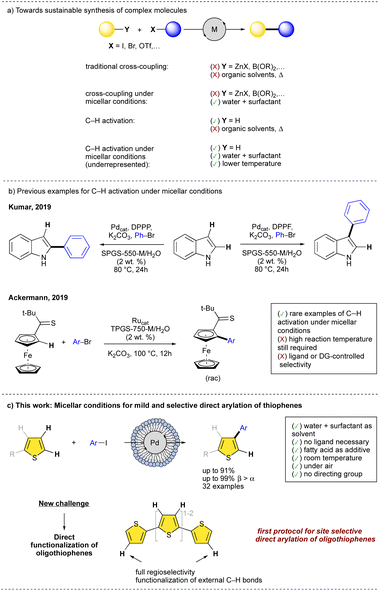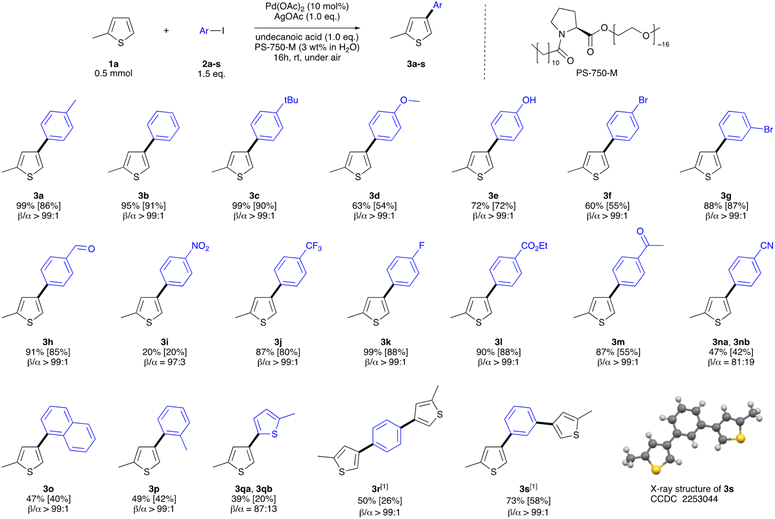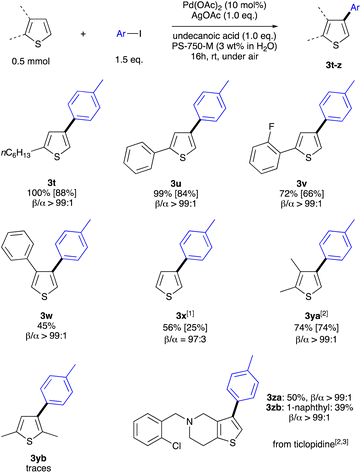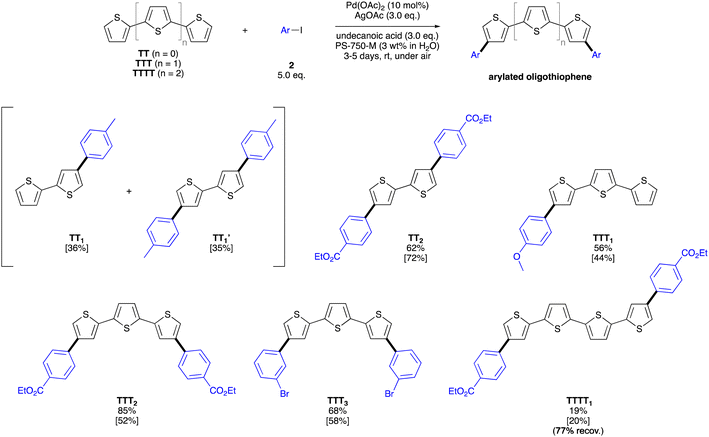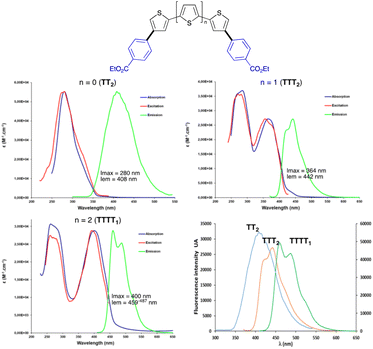 Open Access Article
Open Access ArticleMicellar catalysis: a green solution to enable undirected and mild C–H activation of (oligo)thiophenes at the challenging β-position†
Pascal
Hauk
a,
Valérie
Mazan
 a,
Fabrice
Gallou
a,
Fabrice
Gallou
 *b and
Joanna
Wencel-Delord
*b and
Joanna
Wencel-Delord
 *a
*a
aLaboratoire d'Innovation Moléculaire et Applications (UMR CNRS 7042), Université de Strasbourg, Université de Haute Alsace, ECPM, 67087 Strasbourg, France. E-mail: wenceldelord@unistra.fr
bChemical & Analytical Development, Novartis Pharma AG, 4056 Basel, Switzerland. E-mail: fabrice.gallou@novartis.com
First published on 5th October 2023
Abstract
The unexpected potential of micellar medium to achieve challenging β-selective direct arylation of (oligo)thiophenes is reported. Thanks to the use of a water/surfactant solution in combination with natural feedstock-derived undecanoic acid as an additive, this high-yielding C–H coupling could be performed regioselectively at room temperature.
Sustainability and limited waste generation are currently important aspects while considering the development of new reactions and chemical processes. The E-factor, calculated by dividing the mass of waste produced during a reaction by the unit mass of the product, is a crucial parameter for determining the environmental acceptability of the reaction.1,2 Not surprisingly, organic solvents are usually the major component while calculating this “greenness” parameter and thus development of synthetic solutions overcoming the need for organic solvents is an important field of modern synthetic chemistry. Following this aim, design of catalytic systems performing efficiently in water has been attracting growing attention not only in academia,3–6 but also in industry.7–9 The use of surfactants allows a diversity of organic reactions to be carried out in water, in addition to dealing with the expected solubility or instability issues. The exceptional recent achievements in micellar cross-coupling reactions clearly highlight additional key advantages attributed to the use of surfactants, including amplified selectivity and reactivity, milder reaction conditions and frequently decreased catalyst loadings.10,11 Consequently, Suzuki-Miyaura,6,12,13 Buchwald-Hartwig,14,15 Sonogashira-Hagihara16 or even sensitive Negishi couplings17,18 can now be effectively run using aqueous surfactant medium as the bulk medium, thus offering impactful and sustainable alternatives, particularly for larger-scale industrial processes19 (Fig. 1a). Even the α-arylation of nitriles via sensible carbanion intermediates was reported in a micellar environment, highlighting the potential of stabilizing sensitive intermediates from hydrolysis.20 While aiming further progress towards “ideal and sustainable” organic synthesis, the use of simple, non-prefunctionalized substrates in C–H activation type reactions to build up molecular complexity is an additional important lever.
The last decade has therefore been clearly marked by outstanding progress in the field of C–H activation, furnishing a diversity of complex cross-coupling products while reducing waste generation and the number of steps.21,22 The possibility of creating not only C–C, but also C–O, C–N or C–X bonds starting from commonly considered latent C–H bonds opens unprecedented perspectives to rapidly access molecular complexity and diversify advanced organic molecules. The combination of micellar chemistry with C–H activation holds therefore a unique potential towards modern and sustainable chemistry. Indeed, in addition to (1) improved overall environmental footprint, (2) unusual selectivity, (3) higher reactivities and (4) milder reaction conditions could be expected and consequently (5) increased functional group tolerance might be observed. However, despite the well-established precedents in Pd-catalyzed cross-couplings under micellar conditions, the implementation of surfactants into the C–H activation field is far from trivial.23 After the pioneering contributions from Lipshutz24 dating as early as 2010, additional sporadic examples of Ru-catalyzed and Pd-catalyzed functionalization of ferrocenes and indoles were reported by Ackermann25 and Kumar26 in 2019 (Fig. 1b). Despite the originality of these contributions, the benefit of micellar conditions was limited to the avoidance of organic solvents, but no impact on selectivity or the reaction mechanism could be evidenced, while also not avoiding elevated reaction temperatures.
Thiophenes and oligo-thiophenes are widely recognized for their important applications ranging from pharmaceuticals27,28 to organic materials29–33 and semi-conductors.34,35 Traditionally, cross-coupling approaches were used to construct functionalized thiophenes via an α-bromination sequence, but recently various C–H activation protocols have offered valuable alternatives to the standard synthetic strategies. The serious limitation of the direct C–H activation approach stems from its inherent selectivity, i.e. selective functionalization of the more acidic α-position via acetate induced concerted-metalation–deprotonation (CMD)36–40 or the base-assisted internal electrophilic substitution-type (BIES) mechanism.39 Undirected β-selective functionalization hence remains very challenging. The rare examples reported in the literature generally require the use of elaborated coupling partners (such as hypervalent iodines,41 triaryl antimony difluorides42 or aryl silanes43), rather than harsh reaction conditions44,45 and/or non-benign solvents46 or heterogeneous catalysts.41 Moreover, the regioselective direct β-arylation of oligothiophenes presents an additional unaddressed challenge and therefore design of alternative catalytic systems allowing mild, selective, and general direct diversification of thiophenes and oligothiophenes is an important synthetic defy.
Herein, we report the unique implementation of surfactant chemistry for advanced undirected β-selective direct arylation of (oligo)thiophenes (Fig. 1c). The use of micellar conditions in combination with a fatty acid additive translates into high reactivity under temperature as low as 25 °C using a green solvent. Moreover, this original catalytic system can now be used for the direct functionalization of oligothiophenes, thus providing appealing extended thiophene-based fluorescent scaffolds.
At the outset of our study, 2-methylthiophene 1a and 4-iodotoluene 2a were selected as coupling partners. Encouragingly, under micellar conditions in water, utilizing the PS-750-M surfactant developed by Handa,5 the desired reaction occurred at room temperature, affording product 3 in 24% yield (Table 1, entry (2)). Interestingly, while the presence of non-carboxylic acid (pTsOH) slowed down the desired coupling (entry 3), a dramatic increase of the reactivity was reached upon addition of a fatty acid ligand. In the presence of undecanoic acid, 3 was generated in 88% yield (entry 1), while a related sodium salt turned out to be less productive (entry 4). A screening of various carboxylic acids revealed that increased lipophilicity of the additive is advantageous for the reaction, providing more homogeneous mixtures, whereas more acidic ones (TFA to AcOH) did not enhance the yield. We suppose that this trend in lipophilicity of the carboxylic acid is based on its properties to anchor the reaction components on the interface of the surfactant. Alternatively, it's also possible that the carboxylic acids are actively involved in the formation of mixed-micelles, a phenomenon previously observed by Handa,47 thus enhancing the homogeneity of the reaction mixture.
| Entry | Deviation | Yieldb |
|---|---|---|
| a Standard reaction conditions; aryl iodide (1.5 eq.), Pd(OAc)2 (10 mol%), AgOAc (1.0 eq.), undecanoic acid (1.0 eq.), PS-750-M (3 wt% in H2O), 16 h, rt. b Yield determined by 1H NMR using an internal standard. | ||
| 1 | Nonea | 88% |
| 2 | No carboxylic acid | 24% |
| 3 | pTsOH instead of undec. acid | 8% |
| 4 | Sodium laurate instead of undec. acid | 47% |
| 5 | 1.1 eq. thiophene | 92% |
| 6 | Pd2(dba)3 | 8% |
| 7 | No Pd(OAc)2 | — |
| 8 | No AgOAc | — |
| 9 | Solvent free in 10 eq. undec. acid | — |
| 10 | EtOH as solvent, no PS-750-M | 55% |
| 11 | 2 wt%/1 wt% PS-750-M in H2O | 87%/86% |
| 12 | 2 wt% TPGS-750-M/SPGS-550-M in H2O | 81%/86% |
The best performances were obtained with undecanoic acid or the less costly dodecanoic acid. However, considering the higher melting point of the dodecanoic acid which imposes higher reaction temperatures, undecanoic acid was selected as the optimal additive. A minor increase of the reaction yield was evidenced when using 4-iodotoluene as the limiting reagent (entry 5). Finally, complementary tests revealed low reactivity using a Pd0-precatalyst (entry 6) and no reaction in the absence of the Pd-catalyst, the iodine scavenger silver acetate, or in neat undecanoic acid (entries 7–9). EtOH as solvent was found to be less productive (entry 10). A lower surfactant concentration of PS-750-M (entry 11) provides similar yields on a small scale but formed an inhomogeneous reaction, and a similar effect was found with TPGS-750-M and SPGS-550-M (entry 12), disadvantageous for upscaling (see ESI†).
With the optimized reaction conditions in hand, the scope of the reaction was investigated, focusing first on diverse aryl iodides (Scheme 1). The reaction tolerated numerous functional groups in the para position with respect to the iodine. Electron-rich aryl iodides provided the desired products in high yields and full β-selectivity (3a–d). Importantly even 4-iodophenol performed well, as the corresponding product 3e was isolated in 72% yield. Bromo-substituted para- and meta-iodoarenes underwent the reaction smoothly (3f, 3g). Other electron-poor coupling partners, except for 4-nitroiodobenzene, are also perfectly compatible with this protocol, furnishing 3h–n in nearly quantitative yields. Worth mentioning is the high yielding reaction with 4-iodobenzaldehyde; 3h was isolated in 85% yield. Remarkably, the reaction is still productive with sterically demanding aryl-iodides (3o–p) and the di-thiophene product (3q) was assembled, while using 2-iodo-thiophene as the coupling partner. Besides, 1,4- and 1,3-di-iodobenzenes underwent double arylation, delivering original polyaromatic compounds (3r–s). The structure of 3s could be unambiguously confirmed by X-ray structure analysis, thus further proving the β-selectivity.46
Subsequently, the scope of the micellar reaction was assessed with different thiophenes 3t–3z (Scheme 2). The reaction performed remarkably well for electron rich, aryl- or alkyl-substituted thiophenes delivering the coupling products 3t–3u in quantitative yields, with slightly lower yields for the electron poor 3v. 3-Phenyl substituted thiophene is also an efficient substrate, but the corresponding product 3w was obtained in a decreased yield of 45%. This protocol tolerates unsubstituted thiophene (3x), but an increased yield of 74% (3ya) was obtained when using the 2,3-dimethylthiophene substrate. In contrast, no product formation was observed using the corresponding 2,5-dimethylthiophene substrate (3yb). The synthetic value of our reaction was further illustrated by its application to a straightforward late-stage diversification of the platelet aggregation inhibitor ticlopidine. Indeed, direct arylation of this substrate occurred smoothly, affording 3za–3zb in synthetically useful yield. Notably, full β-selectivity achieved in our case is complementary to the previously observed α-selectivity, favoured under thermal conditions.48
The total lack of reactivity of 2,5-dimethylthiophene under the optimized reaction conditions is surprising and complementary to the results observed under standard homogeneous conditions using hypervalent iodines as the coupling partners.41 This result thus opens new perspectives while considering a possible direct arylation of oligothiophenes. Indeed, it can be speculated that our micellar protocol should promote exclusively direct arylation at the external positions, while the internal thiophene motif should remain untouched.
To validate this hypothesis, a set of oligothiophenes was investigated under our protocol, starting with di-thiophene TT and 4-iodotoluene as coupling partners (Scheme 3). A minor tuning of the reaction conditions allowed isolation of the desired functionalization product, as a separable mixture of the monoarylated TT1 and diarylated TT1′ products in comparable 35 and 36% yields. The limited solubility and aggregation of the monoarylated product arguably account for the sluggish second arylation step. Interestingly, the use of ethyl-para-iodobenzoate increases the solubility of the monoarylated thiophene intermediate, thus allowing the enhancement of selective diarylation thus furnishing diarylated TT2 in 72% yield. To further explore the limits of our protocol towards late-stage functionalization of oligothiophenes, terthiophene TTT was tested. In this case the solubility and aggregation of the substrate and products drastically impact the mono vs. diarylation selectivity as well. When TTT was reacted with 4-iodoanisole, monoarylated product TTT1 was formed selectively. In contrast, ethyl-para-iodobenzoate and 1-bromo-3-iodobenzene furnished selectively the diarylated compounds TTT2 and TTT3 in high isolated yields of 52% and 58% respectively, despite the excess of the aryl iodide coupling partner. Remarkably, even quaterthiophene TTTT which has a low solubility in organic solvents is compatible with our catalytic system, furnishing TTTT1. Although this yield is rather low, it corresponds to two C–C bond creation events for highly insoluble and challenging substrates.49,50 To the best of our knowledge, this micellar protocol is the unique solution allowing late-stage β-diversification of oligothiophenes, key structures in materials science.
Subsequently, the mechanism of this reaction was investigated. Based on the literature precedents, three types of mechanisms, i.e. an acetate catalyzed CMD C–H activation, a SEAr or Heck-type mechanism could be expected. To validate one of these scenarios, several experiments using a deuterated substrate and/or solvent were performed (Scheme 4). While the CMD mechanism would facilitate the most acidic proton, we would expect an α-arylated product in combination with an H/D scrambling under aryl halide-free conditions,51,52 both which we did not observe (Scheme 4a). Surprisingly, when our standard reaction was run in D2O/PS-750-M medium, the desired product 3u was formed as expected, but an extensive H/D scrambling at the C5 position was observed (d-3u, Scheme 4b). This result seems incoherent with the Heck-type direct arylation of benzothiophenes described by Larrosa46 and would also not be expected by an SEAr mechanism. Besides, when the arylated product 3u was submitted to the standard reaction conditions in D2O/surfactant medium, deuteration at the C5-position was also evidenced, together with formation of the traces of the double arylated product 3ub (Scheme 4c). These results might suggest that the presence of Ar–I species is necessary to form catalytically active species. In addition, the crucial role of the silver salts in our system (Table 1, entry 8) might indicate that AgOAc plays a role of a halide abstractor from a saturated Pd-intermediate, generated upon oxidative addition of Pd(II) to Ar–I. Based on these experimental results, a surmised catalytic cycle is depicted in Scheme 5.
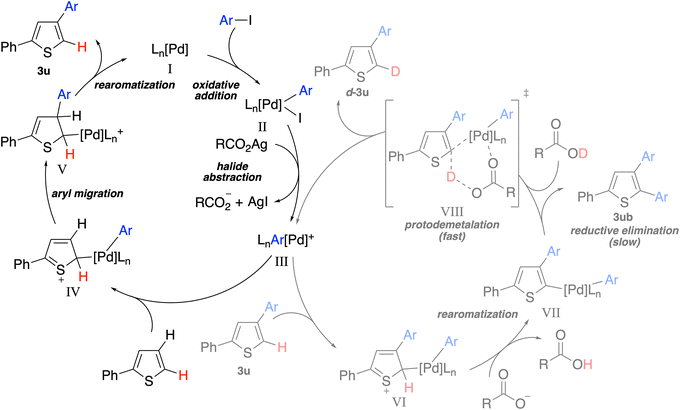 | ||
| Scheme 5 Proposed mechanism for palladium catalyzed direct arylation in a D2O/PS-750-M medium. Ar = pTol, R = Me/nC10H21. C–C bond forming cycle (left), H/D scrambling cycle (right). | ||
The catalytic cycle is expected to start by an oxidative addition step, generating Pd(IV)-species II. Halide abstraction using silver salts thus occurs, affording the cationic palladium species III, followed by carbopalladation at the C5 position (IV). The Ar-moiety is subsequently installed at the C4 position via aryl migration and rearomatization (V), affording the observed product 3u. Such a catalytic system seems indeed coherent with the results shown in Scheme 4a, but does not explain reactions b and c. The H/D scrambling observed in Scheme 4b and c might thus indicate a parallel catalytic cycle, initiated by the second C–H activation of 3u by Pd III species. Species VI is subsequently either converted into to diarylated compound 3ubvia rearomatization (VII) and reductive elimination or the deuteration at the C5 position takes place via protodemetallation (VIII), releasing d-3u. As the reaction occurs in aqueous medium with PS-750-M surfactant, the interior part of the micelle is expected to be relatively polar. Accordingly, stabilization of the cationic Pd-species occurs.
Regarding the appealing properties of oligothiophenes in materials science and their frequently observed fluorescent properties,53,54 the physicochemical properties of the few herein obtained oligothiophenes have been investigated (Fig. 2). We observed that the extension of the synthesized conjugated oligothiophene systems translates into absorption and fluorescence being shifted towards visible light (see ESI†). This trend is evident by extending the oligothiophene scaffold from bithiophene (TT2) to terthiophene (TTT2) and quaterthiophene (TTTT1) with a constant coupling partner.
Conclusions
In conclusion, we report herein a unique protocol for regioselective, mild and sustainable β-arylation of thiophenes under micellar conditions, using the lipophilic additive undecanoic acid. Remarkably, the use of water/surfactant as bulk medium allows not only to reach “unusual” selectivity, but also to perform the desired transformation at room temperature. This new micellar protocol also gives a unique opportunity to selectively functionalize oligothiophenes, thus allowing selective arylation exclusively at external β-positions, even in the presence of up to 6 internal β-H positions. We strongly believe that continued efforts and improved understanding of the physico-chemical phenomena associated with surfactant-enabled chemistry in water will eventually lead to more effective and selective catalytic systems.Data availability
Synthetic procedures, further experimental details, characterization data (NMR) and X-ray crystallography data are available in the ESI.†Author contributions
P. H., F. G. and J. W.-D. contributed to the concept of the research. P. H. performed the optimization, the scope and all synthetic work. V. M. contributed with physicochemical measurements. P. H., F. G. and J. W.-D. were involved in the preparation of the manuscript.Conflicts of interest
There are no conflicts to declare.Acknowledgements
We thank the European Union H2020 research and innovation program under the Marie S. Curie Grant Agreement no. 860762 (MSCA ITN: CHAIR) for the extensive funding. We are grateful to Dr Nathalie Gruber for single crystal X-ray diffraction analysis, and Stephane Rodde for DLS. We warmly thank Dr J. F. Nierengarten who allowed us to carry out emission and excitation spectra with his LS55 device.Notes and references
- R. A. Sheldon, J. Mol. Catal. A: Chem., 1996, 107, 75–83 CrossRef CAS.
- R. A. Sheldon, Green Chem., 2007, 9, 1273–1283 RSC.
- B. H. Lipshutz, S. Ghorai, A. R. Abela, R. Moser, T. Nishikata, C. Duplais, A. Krasovskiy, R. D. Gaston and R. C. Gadwood, J. Org. Chem., 2011, 76, 4379–4391 CrossRef CAS PubMed.
- P. Klumphu and B. H. Lipshutz, J. Org. Chem., 2014, 79, 888–900 CrossRef CAS PubMed.
- J. Brals, J. D. Smith, F. Ibrahim, F. Gallou and S. Handa, ACS Catal., 2017, 7, 7245–7250 CrossRef CAS.
- S. Handa, F. Ibrahim, T. N. Ansari and F. Gallou, ChemCatChem, 2018, 10, 4229–4233 CrossRef CAS.
- F. Gallou, N. A. Isley, A. Ganic, U. Onken and M. Parmentier, Green Chem., 2016, 18, 14–19 RSC.
- S. Sharma, J. Das, W. M. Braje, A. K. Dash and S. Handa, ChemSusChem, 2020, 13, 2859–2875 CrossRef CAS PubMed.
- A. Steven, Synthesis, 2019, 51, 2632–2647 CrossRef CAS.
- S. Handa, M. P. Andersson, F. Gallou, J. Reilly and B. H. Lipshutz, Angew. Chem., Int. Ed., 2016, 55, 4914–4918 CrossRef CAS PubMed.
- E. B. Landstrom, S. Handa, D. H. Aue, F. Gallou and B. H. Lipshutz, Green Chem., 2018, 20, 3436–3443 RSC.
- B. H. Lipshutz and A. R. Abela, Org. Lett., 2008, 10, 5329–5332 CrossRef CAS PubMed.
- T. Nishikata, A. R. Abela, S. Huang and B. H. Lipshutz, J. Am. Chem. Soc., 2010, 132, 4978–4979 CrossRef CAS PubMed.
- C. E. Brocklehurst, F. Gallou, J. C. D. Hartwieg, M. Palmieri and D. Rufle, Org. Process Res. Dev., 2018, 22, 1453–1457 CrossRef CAS.
- C. Salomé, P. Wagner, M. Bollenbach, F. Bihel, J.-J. Bourguignon and M. Schmitt, Tetrahedron, 2014, 70, 3413–3421 CrossRef.
- J. Struwe, L. Ackermann and F. Gallou, Chem Catal., 2023, 3, 100485 CrossRef CAS.
- Y. Hu, M. J. Wong and B. H. Lipshutz, Angew. Chem., Int. Ed., 2022, 134, e202209784 CrossRef.
- M. P. Andersson, F. Gallou, P. Klumphu, B. S. Takale and B. H. Lipshutz, Chem.—Eur. J., 2018, 24, 6778–6786 CrossRef CAS PubMed.
- M. Parmentier, M. Wagner, R. Wickendick, M. Baenziger, A. Langlois and F. Gallou, Org. Process Res. Dev., 2020, 24, 1536–1542 CrossRef CAS.
- M. Bihani, T. N. Ansari, L. Finck, P. P. Bora, J. B. Jasinski, B. Pavuluri, D. K. Leahy and S. Handa, ACS Catal., 2020, 10, 6816–6821 CrossRef CAS.
- T. Dalton, T. Faber and F. Glorius, ACS Cent. Sci., 2021, 7, 245–261 CrossRef CAS PubMed.
- T. Rogge, N. Kaplaneris, N. Chatani, J. Kim, S. Chang, B. Punji, L. L. Schafer, D. G. Musaev, J. Wencel-Delord, C. A. Roberts, R. Sarpong, Z. E. Wilson, M. A. Brimble, M. J. Johansson and L. Ackermann, Nat. Rev. Methods Primers, 2021, 1, 43 CrossRef CAS.
- P. Hauk, J. Wencel-Delord, L. Ackermann, P. Walde and F. Gallou, Curr. Opin. Colloid Interface Sci., 2021, 56, 101506 CrossRef CAS.
- T. Nishikata, A. R. Abela and B. H. Lipshutz, Angew. Chem., Int. Ed., 2010, 49, 781–784 CrossRef CAS PubMed.
- S. R. Yetra, T. Rogge, S. Warratz, J. Struwe, W. Peng, P. Vana and L. Ackermann, Angew. Chem., Int. Ed., 2019, 58, 7490–7494 CrossRef CAS PubMed.
- G. N. Vaidya, S. Fiske, H. Verma, S. K. Lokhande and D. Kumar, Green Chem., 2019, 21, 1448–1454 RSC.
- G. Montalescot, S. D. Wiviott, E. Braunwald, S. A. Murphy, C. M. Gibson, C. H. McCabe and E. M. Antman, Lancet, 2009, 373, 723–731 CrossRef CAS PubMed.
- A. K. Jacobson, Best Pract. Res., Clin. Haematol., 2004, 17, 55–64 CrossRef CAS PubMed.
- A. Åslund, K. P. R. Nilsson and P. Konradsson, J. Chem. Biol., 2009, 2, 161–175 CrossRef PubMed.
- D. Y. W. Ng, R. Vill, Y. Wu, K. Koynov, Y. Tokura, W. Liu, S. Sihler, A. Kreyes, S. Ritz, H. Barth, U. Ziener and T. Weil, Nat. Commun., 2017, 8, 1850 CrossRef PubMed.
- M. Irie and K. Uchida, Bull. Chem. Soc. Jpn., 1998, 71, 985–996 CrossRef CAS.
- H. Kamiya, S. Yanagisawa, S. Hiroto, K. Itami and H. Shinokubo, Org. Lett., 2011, 13, 6394–6397 CrossRef CAS PubMed.
- B. Oruganti, P. Pál Kalapos, V. Bhargav, G. London and B. Durbeej, J. Am. Chem. Soc., 2020, 142, 13941–13953 CrossRef CAS PubMed.
- S. Hotta and S. A. Lee, Synth. Met., 1999, 101, 551–552 CrossRef CAS.
- L. Zhang, N. S. Colella, B. P. Cherniawski, S. C. B. Mannsfeld and A. L. Briseno, ACS Appl. Mater. Interfaces, 2014, 6, 5327–5343 CrossRef CAS PubMed.
- T. Okazawa, T. Satoh, M. Miura and M. Nomura, J. Am. Chem. Soc., 2002, 124, 5286–5287 CrossRef CAS PubMed.
- B. Glover, K. A. Harvey, B. Liu, M. J. Sharp and M. F. Tymoschenko, Org. Lett., 2003, 5, 301–304 CrossRef CAS PubMed.
- B. Liégault, D. Lapointe, L. Caron, A. Vlassova and K. Fagnou, J. Org. Chem., 2009, 74, 1826–1834 CrossRef PubMed.
- S. Bensaid, J. Roger, K. Beydoun, D. Roy and H. Doucet, Synth. Commun., 2011, 41, 3524–3531 CrossRef CAS.
- M. H. Daniels, J. R. Armand and K. L. Tan, Org. Lett., 2016, 18, 3310–3313 CrossRef CAS PubMed.
- D.-T. D. Tang, K. D. Collins, J. B. Ernst and F. Glorius, Angew. Chem., Int. Ed., 2014, 53, 1809–1813 CrossRef CAS PubMed.
- Y. Kitamura, Y. Murata, A. Oguri, M. Matsumura, N. Kakusawa, H. Naka and S. Yasuike, Asian J. Org. Chem., 2018, 138–143 Search PubMed.
- K. Funaki, T. Sato and S. Oi, Org. Lett., 2012, 14, 6186–6189 CrossRef CAS PubMed.
- K. Ueda, S. Yanagisawa, J. Yamaguchi and K. Itami, Angew. Chem., Int. Ed., 2010, 49, 8946–8949 CrossRef CAS PubMed.
- K. Yuan and H. Doucet, Chem. Sci., 2014, 5, 392–396 RSC.
- C. Colletto, S. Islam, F. Juliá-Hernández and I. Larrosa, J. Am. Chem. Soc., 2016, 138, 1677–1683 CrossRef CAS PubMed.
- S. Sharma, G. Kaur and S. Handa, Org. Process Res. Dev., 2021, 25, 1960–1965 CrossRef CAS.
- D. Atoui, H. Li, R. Ben Salem, T. Roisnel, J. Soulé and H. Doucet, Asian J. Org. Chem., 2019, 8, 2155–2161 CrossRef CAS.
- T. Seo, K. Kubota and H. Ito, J. Am. Chem. Soc., 2023, 145, 6823–6837 CrossRef CAS PubMed.
- T. Seo, N. Toyoshima, K. Kubota and H. Ito, J. Am. Chem. Soc., 2021, 143, 6165–6175 CrossRef CAS PubMed.
- B. Liégault, I. Petrov, S. I. Gorelsky and K. Fagnou, J. Org. Chem., 2010, 75, 1047–1060 CrossRef PubMed.
- S. I. Gorelsky, D. Lapointe and K. Fagnou, J. Am. Chem. Soc., 2008, 130, 10848–10849 CrossRef CAS PubMed.
- R. S. Becker, J. S. de Melo, A. L. Macanita and F. Elisei, J. Phys. Chem., 1996, 100, 18683–18695 CrossRef CAS.
- S. C. Rasmussen, S. J. Evenson and C. B. McCausland, Chem. Commun., 2015, 51, 4528–4543 RSC.
Footnote |
| † Electronic supplementary information (ESI) available. CCDC 2253044. For ESI and crystallographic data in CIF or other electronic format see DOI: https://doi.org/10.1039/d3sc03708h |
| This journal is © The Royal Society of Chemistry 2023 |

